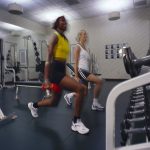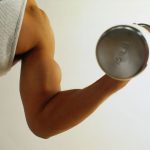
Want two moves that will effectively develop your lower body? Then add lunges and squats to your strength-training workout. These exercises primarily use your own body weight to effectively strengthen muscles, and can be adapted for both beginners and more advanced athletes. The lunge works the quads, hamstrings, glutes and, to a lesser degree, the lower leg muscles. Lunges can be done as a forward or reverse movement. The reverse is easier for beginners. Step backward with your left foot, extending the leg behind you as you bend the right knee until the right thigh is parallel with the floor or as close as feels comfortable. Press your right heel into the floor to bring yourself back to the starting position. When you want to progress, switch to the forward lunge. The left foot steps forward with the knee bending over the foot as you lower your right knee behind you. You can draw on your body weight or intensify results by holding hand weights. Whatever your level, repeat only as many times as you are able to do so with correct form. For beginners, that may be as few as five lunges with each leg. Build up to three sets of 10 to 20 reps on each leg. The squat targets the quads and hamstrings. Developing these muscles will help protect the knees. Stand… read on >




























-300x200.jpg)







-300x169.jpg)
